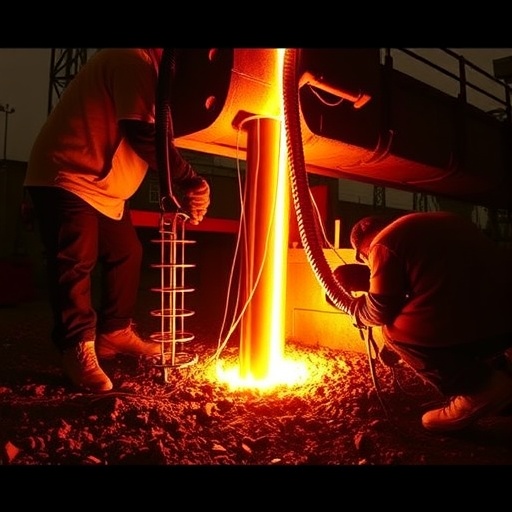In a groundbreaking study published in Environmental Earth Sciences, researchers have unveiled new insights into the sealing capabilities of caprocks used in underground gas storage facilities. The study addresses a critical challenge in the energy sector: ensuring the long-term containment of gases stored deep beneath the Earth’s surface. By exploring the breakthrough pressures of caprocks under complex stress conditions, this research provides an advanced understanding of how subterranean geological formations behave when subjected to dynamic stress paths, which is vital for safe and efficient underground gas storage.
Underground gas storage is a cornerstone technology for managing energy supply, offering a way to balance fluctuating demands and stabilize energy markets. However, the security of these storage sites heavily depends on the integrity of the caprock layer—a naturally occurring impermeable rock that acts as a seal, preventing the stored gas from migrating upwards and contaminating groundwater or escaping into the atmosphere. Despite its critical importance, the performance of caprocks under varying stress environments has remained insufficiently understood, until now.
The research team, led by Ban, Liu, and Yang, focused on measuring what is known as “breakthrough pressure” — the minimum pressure required for gas to penetrate through the caprock. Traditional assessments have often relied on simplified scenarios or static stress conditions, failing to replicate the real-world stress variations that occur during gas injection and withdrawal cycles. This study breaks new ground by subjecting caprock samples to complex, multi-axial stress paths that more accurately simulate the natural geomechanical environment.
Their experimental approach involved replicating underground stress regimes using a sophisticated apparatus that applies variable confining and axial stresses to rock samples, replicating the loading and unloading sequences typical of gas storage operations. By continuously monitoring the pressure at which gas begins to migrate through the caprock, the researchers were able to identify crucial trends in the rock’s mechanical response and permeability changes under stress.
Results from this study revealed a non-linear relationship between applied stress and breakthrough pressure. Under certain stress paths, caprocks exhibited enhanced sealing performance with increased breakthrough pressures, suggesting a stress-induced tightening of pore spaces and fracture networks. Conversely, other stress regimes lowered the breakthrough pressure, indicating the potential for microfracture development and compromised integrity. These findings demonstrate that caprock sealing capacity is highly sensitive to the nature of the stress field, challenging the assumption that caprocks are uniformly reliable seals.
Importantly, the study highlights the impact of stress path dependency, evidencing hysteresis effects where the sealing properties change irreversibly after certain loading cycles. This phenomenon suggests that repeated operational stresses in gas storage facilities could degrade caprock sealing over time, raising critical considerations for the design and monitoring of these underground reservoirs. The temporal evolution of caprock properties under cyclic stress emphasizes the need for more dynamic and ongoing assessments rather than relying on single-point evaluations.
Furthermore, the research incorporates microstructural analyses that provide insights into the microscale mechanisms behind sealing behavior variations. High-resolution imaging revealed subtle changes in mineral grain contacts and pore structure under different stress paths. These microstructural alterations directly correlate with macroscopic breakthrough pressure measurements, bridging the gap between physical observations and mechanical performance.
The implications of this study extend beyond underground gas storage. Enhanced understanding of caprock mechanics under complex stress conditions can inform petroleum engineering, carbon capture and storage (CCS), and geothermal energy exploitation. Each of these fields relies on the ability of caprocks to contain fluids securely over long periods, making the findings broadly applicable to subsurface resource management.
Experts suggest that the methodology introduced in this research could become a new standard for evaluating geological seals. By accounting for the intricacy of natural stress paths, engineers and geologists can better predict seal integrity and mitigate risks associated with leakage or catastrophic failure. This advancement supports the growing global emphasis on sustainable and safe energy technologies.
The attention to stress path complexity also uncovers pathways for optimizing underground gas storage strategies. Adjusting injection pressures and monitoring stress evolutions could enhance storage capacity while maintaining safety thresholds informed by breakthrough pressure values. Such operational refinements can improve the economic and environmental footprint of underground storage facilities.
Looking ahead, the authors advocate for further experimental campaigns incorporating real reservoir conditions, including temperature variations and chemical interactions between gases and host rocks. Integrating these factors will provide an even more comprehensive picture of caprock behavior, ultimately guiding better management and regulation frameworks.
In conclusion, this study offers a timely and technical leap forward in understanding the sealing capacity of geological formations underpinning underground gas storage. The detailed assessment of breakthrough pressures under realistic, complex stress paths not only informs safer energy storage practices but also accelerates innovation across resource extraction and environmental protection sectors. As the world increasingly turns toward sustainable energy solutions, such rigorous scientific evaluations are indispensable for ensuring long-term subsurface integrity and economic viability.
Subject of Research: Evaluation of the sealing capacity of caprocks in underground gas storage by measuring breakthrough pressure under complex stress paths.
Article Title: Evaluation on the sealing capacity of caprocks in underground gas storage by measuring breakthrough pressure under complex stress paths.
Article References:
Ban, S., Liu, H., Yang, C. et al. Evaluation on the sealing capacity of caprocks in underground gas storage by measuring breakthrough pressure under complex stress paths. Environ Earth Sci 84, 560 (2025). https://doi.org/10.1007/s12665-025-12533-5
Image Credits: AI Generated




